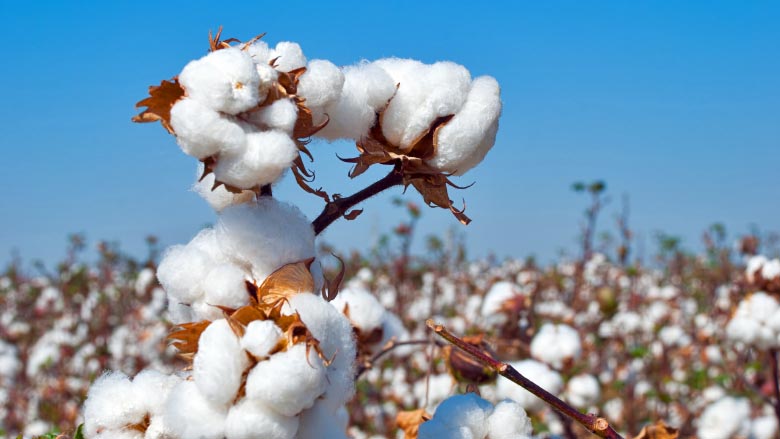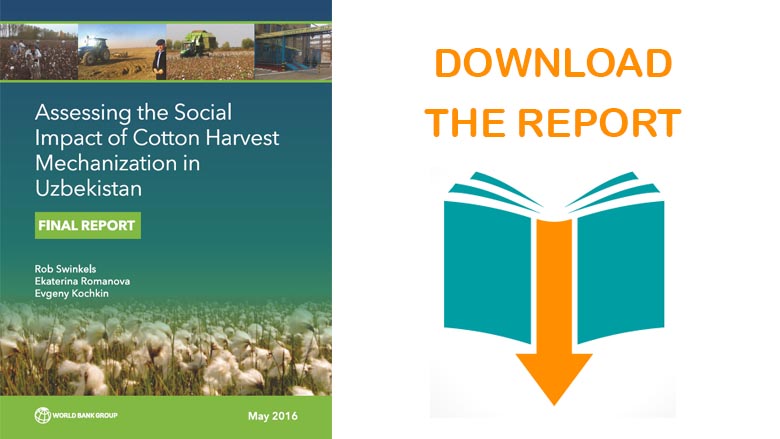Uzbekistan is one of the few cotton-growing countries that has not mechanized the cotton harvest and continues to rely on manual labor to pick cotton. In 2014, the Government of Uzbekistan decided to actively promote mechanization of the cotton harvest. This came partially as a response to the international pressure regarding the use of mobilized labor in cotton picking.
Under Uzbekistan’s state-order system it is compulsory for many farmers to grow cotton. They are contractually obligated to produce stipulated quantities that are annually set by the government, and must sell their produce to the government at a price fixed by the government.
Almost all cotton in Uzbekistan is harvested by hand. An estimated 2.2-3 million people were involved in at least some aspect of the cotton harvest during the 2014 season. Unable to find a sufficient number of seasonal workers, farmers often resort to labor that is mobilized by local and regional authorities.
While cotton harvest mechanization reduces the need for state-mobilized labor for manual cotton picking it may also have an impact on those who rely on cash earned from picking cotton for their livelihoods. In order to assess this possible impact, a social impact assessment of cotton harvest mechanization was undertaken in 2015.
The objective of the assessment was to (i) evaluate the ex-ante social impact of the policy to mechanize cotton harvesting on cotton pickers and vulnerable private farmers; and (ii) identify ways to mitigate the policy’s potential negative impacts on these groups and to make these reforms more acceptable to them.
The assessment is based on the collection and analysis of qualitative data and two background studies. Data were gathered in four regions that vary in terms of labor scarcity, area of land under cotton, cotton production conditions, and experience with mechanization.
Study findings and policy recommendations were discussed with different stakeholders in Tashkent in June 2015 and April 2016. The main national counterparts for this work were the Ministry of Labor, the Federation of Trade Unions, and the Chamber of Commerce and Industry. The Centre for Economic Research provided useful feedback. The study was funded by the Poverty and Social Impact Assessment Trust Fund.
Main Findings
- Manual cotton picking requires approximately three passes. Each pass lasts up to 10 days, but varies by quality and volume of cotton available. With each pass the quality and volume of cotton declines.
- Local pickers, particularly women, are keen to harvest cotton during the first two passes, when open cotton bolls are plentiful and picking productivity is high. Toward the end of the season, however, when sometimes a third or even a fourth pass is conducted, their interest drops significantly.
- Farmers with cotton fields that are far from population points (50-120 km) have difficulty attracting villagers to pick cotton, also because their yields tend to be low. The risk of state-mobilized and involuntary labor may be highest here.
- In each district, a cotton-picking committee is established to organize, coordinate, and monitor the process of picking cotton.
- Pickers from outside the area are arranged by the cotton picking committee. These pickers may include government employees, factory workers, and students (older than 18). Farmers indicate that these workers are less qualified, less experienced and less motivated.
- Farmers are interested to mechanize cotton harvest but have limited information and knowledge about mechanization process, as well as limited access to acceptable harvesters.
- Farmers with remote, poor-quality land that has limited access to irrigation water – often the most vulnerable farmers – have the most difficulty finding pickers. These are the farmers that will benefit from mechanization the most.
- Local cotton pickers prefer manual picking because the payment is made regularly and in cash – a significant advantage to other daily agricultural wage activities in a cash-stripped environment. They indicate that cotton harvest mechanization will negatively impact their livelihood and lead to the decline of daily wages for other agricultural works. Female cotton pickers were particularly concerned. At the same time they note that mechanization will allow schools and local hospitals to remain open during the cotton season.
Key recommendations
Short-term mitigation measures:
- To consider instituting a public works program to improve rural infrastructure and to offer alternative income-earning opportunities to vulnerable rural households;
- To explore options for organizing contract labor teams that consist of skilled and effective workers who can compete with mechanized harvesting or find niches for cotton-harvesting work.
- To make available and accessible labor market management information systems that provide information on labor demand, shortages, surpluses, fees, and wage rates across regions.
Medium term reform measures:
- To liberalize farming and allow farmers that currently grow cotton in areas that are less suitable for that crop to switch to more remunerative farm activities that raise land and labor productivity and use less water.
- To further support farmers engaged in high value activities such as horticultural or livestock production that have higher labor productivity than cotton, and thus enable farmers to pay workers attractive daily fees.
- To address structural barriers that prevent rural women who currently pick cotton from accessing formal employment or engaging in alternative income-earning activities.
- To advance agronomic research on cotton varieties that are well suited to Uzbek agronomic conditions and to mechanized cotton harvest.
- To carry out on-farm field testing of different harvesting machines and machine design options before scaling up mechanization of cotton harvest nation-wide.
- To pilot different business models for mechanizing the cotton harvest in order to test the effectiveness, impact, and alternative arrangements for ownership, leasing, and contract service provision, and to address the needs of smaller scale farmers.
- To develop a plan for enabling farmers and pickers to actively engage with the research findings around cotton harvest mechanization and explore new ways forward.
- To strengthen the mechanism for identifying vulnerable households and for expanding the coverage of social assistance program for those households.

